Black-capped chickadee (Parus atricapillus)
So very cute! Our favorite little bird. I buy and raise mealworms just for them. They’re probably the friendliest birds around and are easy to train to come to your hand to eat. I rarely encourage this, though. It’s not good for wildlife to get too friendly with people.
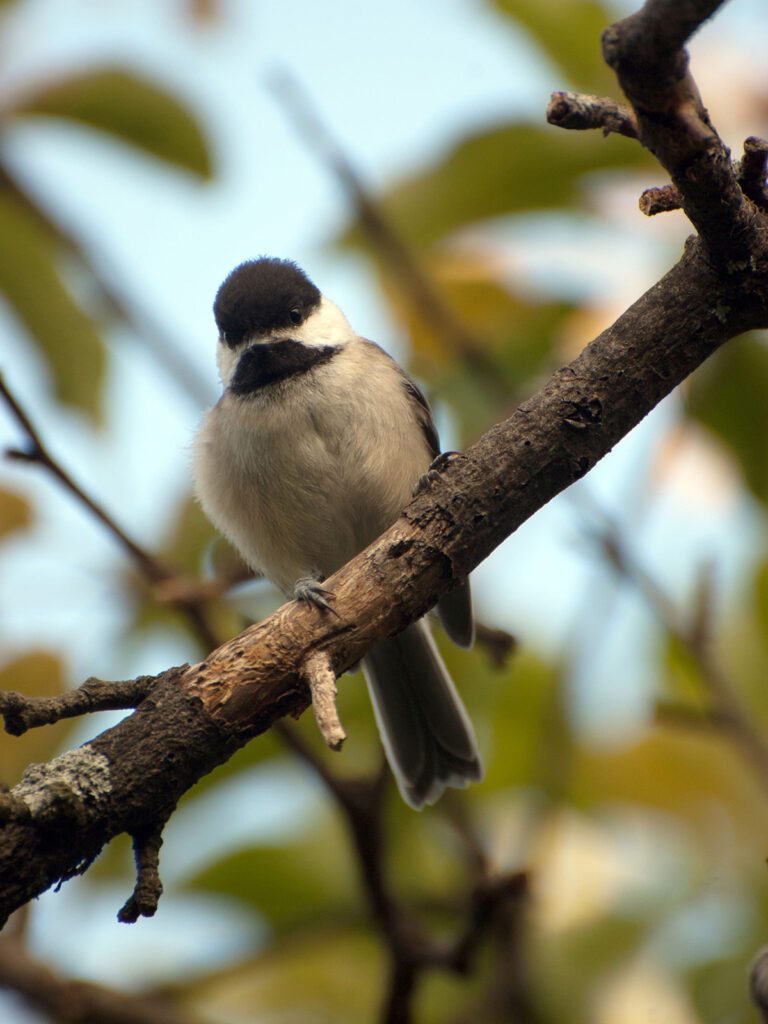
- Learn more:
- Cornell’s Lab of Ornithology:
- Black-capped chickadee
- How chickadees use their brains to survive harsh winters
- American Bird Conservancy:
- Lesley the Bird Nerd:
- Cornell’s Lab of Ornithology:
| YR | J | F | M | A | M | J | J | A | S | O | N | D |
| 24 | 3 | |||||||||||
| 23 | 2 | 2 | 2 | 4 | 4 | 3 | 3 | 3 | ||||
| 22 | 4 | 2 | 8 | 7 | 2 | 3 | 4 | 3 | 3 | |||
| 21 | 5 | 3 | 3 | 3 | 6 | 6 | 4 | 3 | 4 | 3 | 4 | |
| 20 | 3 | 3 | 3 | 6 | 4 | 3 | 4 | 3 | 4 | 5 | ||
| 19 | 2 | 3 | 3 | 6 | 4 | 3 | 5 | 2 | 2 | |||
| 18 | 2 | 3 | 3 | 7 | 7 | 4 | 6 | 4 | 3 | |||
| 17 | 2 | 2 | 3 | 8 | 4 | 3 | 4 | 4 | 4 | 4 | ||
| 16 | 3 | 4 | 3 | 7 | 1 | 4 | · | 4 | 4 | |||
| 15 | 3 | 4 | 4 | 7 | 6 | 4 | 5 | · | · | |||
| 14 | 3 | 2 | 2 | 8 | 7 | 5 | 4 | 5 | 5 | |||
| 13 | 4 | 2 | 2 | 7 | 3 | 4 | 4 | 3 | 2 | |||
| 12 | 2 | 4 | 3 | 6 | 7 | 5 | 5 | 4 | 4 | |||
| 11 | 4 | 3 | 3 | 2 | 2 | 2 | · | 2 | 1 | 2 | 2 | |
| 10 | 5 | 6 | 5 | 3 | 3 | 6 | 5 | 2 | 4 | 4 | 4 | 3 |
| 09 | 6 | 3 | 4 | 6 | 2 | 7 | 9 | 3 | 1 | 5 | 5 | 6 |
| 08 | 4 | 4 | 4 | 4 | 2 | 7 | 4 | 5 | 5 | 5 | 5 | 5 |
| 07 | 6 | 6 | 5 | 4 | 3 | 2 | 4 | 3 | 3 | 3 | 5 | 5 |
| 06 | 6 | 5 | 5 | 2 | 2 | 5 | 3 | 5 | 6 | 4 | 6 | 6 |
| 05 | 5 | 7 | 3 | 2 | 2 | 6 | 2 | 8 | 7 | 6 | 5 | 6 |
| 04 | 7 | 6 | 7 | 4 | 2 | 6 | 4 | 4 | 1 | 5 | 5 | 6 |
| 03 | 6 | 3 | 7 | 4 | 3 | 6 | 3 | 5 | 3 | 4 | 5 | 7 |
| 02 | 4 | 3 | 4 | 2 | 1 | 3 | 3 | 3 | 6 | 3 | 3 | 4 |
| 01 | 4 | 5 | 3 | 2 | 5 | 2 |
Tufted titmouse (Parus bicolor)
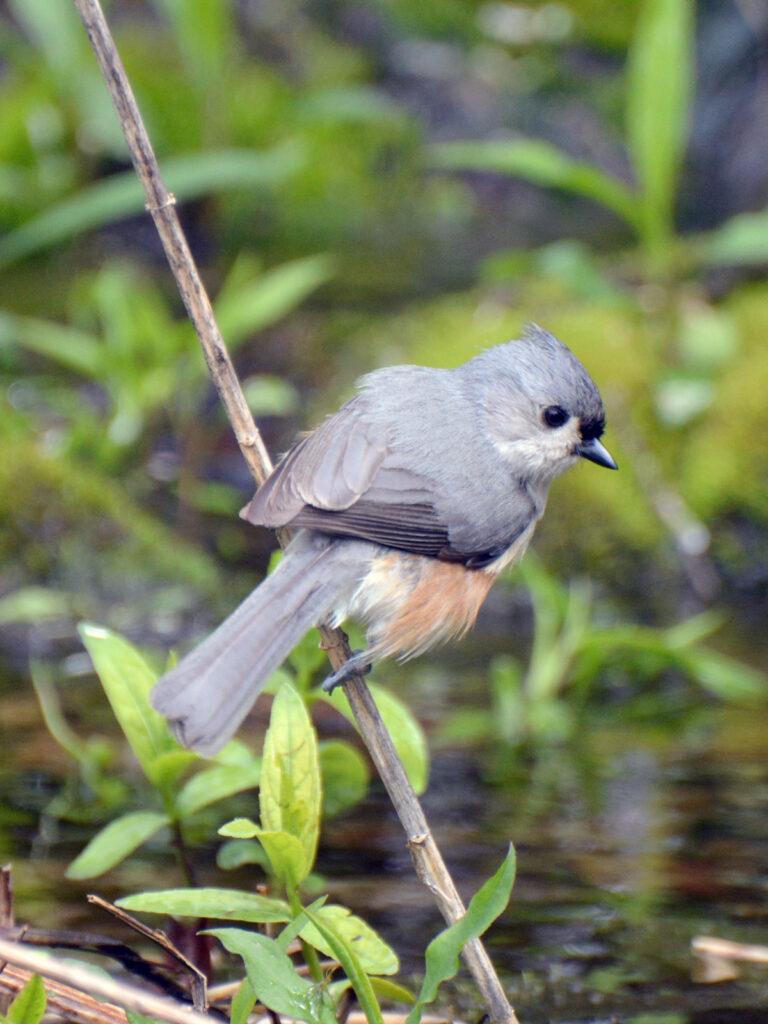
As cute as the chickadee, but not quite as friendly. We don’t see titmice as much as I’d like, though they’re in the area.
- Learn more:
- Cornell’s All About Birds: Tufted titmouse
- American Bird Conservancy: Bird of the Week
| YR | J | F | M | A | M | J | J | A | S | O | N | D |
| 24 | 2 | |||||||||||
| 23 | 2 | 2 | 2 | 5 | 2 | 2 | 2 | 2 | ||||
| 22 | 2 | 2 | 2 | 7 | 4 | 4 | 4 | 4 | 3 | |||
| 21 | 3 | 2 | 2 | 2 | 2 | 2 | 2 | 2 | 2 | 2 | 1 | |
| 20 | 2 | 2 | 2 | 2 | 2 | 3 | 3 | 3 | 3 | 3 | ||
| 19 | · | 1 | · | 2 | 2 | · | · | 2 | 2 | |||
| 18 | 2 | 2 | 2 | 2 | · | · | 2 | 2 | 1 | |||
| 17 | 2 | 2 | 1 | 2 | · | · | · | 1 | 3 | 3 | ||
| 16 | 2 | 2 | 2 | 2 | · | · | · | 2 | 1 | |||
| 15 | · | · | · | · | 1 | · | · | · | 3 | |||
| 14 | 1 | 1 | 1 | 2 | · | 2 | 1 | 1 | · | |||
| 13 | 1 | 1 | 1 | · | · | · | · | · | · | |||
| 12 | · | · | · | · | · | · | 1 | 2 | 2 | |||
| 11 | 2 | 2 | 2 | 2 | 1 | · | · | · | 1 | 2 | · | |
| 10 | 2 | 2 | 2 | · | · | · | · | · | · | 2 | 2 | 2 |
| 09 | 2 | 2 | 2 | 1 | · | · | 1 | · | · | 2 | 2 | 2 |
| 08 | 1 | 2 | 2 | 2 | · | · | 1 | · | · | 2 | 2 | 2 |
| 07 | 2 | 1 | 2 | 2 | 2 | · | · | · | 2 | 2 | 4 | 3 |
| 06 | 2 | 1 | 1 | 2 | 1 | · | · | · | · | 2 | 2 | 2 |
| 05 | 1 | 1 | 1 | · | · | · | · | · | · | 1 | 2 | · |
| 04 | · | · | · | · | · | · | · | · | · | 2 | 2 | 1 |
| 03 | · | · | · | · | · | · | · | · | · | · | · | · |
| 02 | · | · | · | · | · | · | · | · | · | · | · | · |
| 01 | · | · | · | · | · | · |
Red-breasted nuthatch (Sitta canadensis)
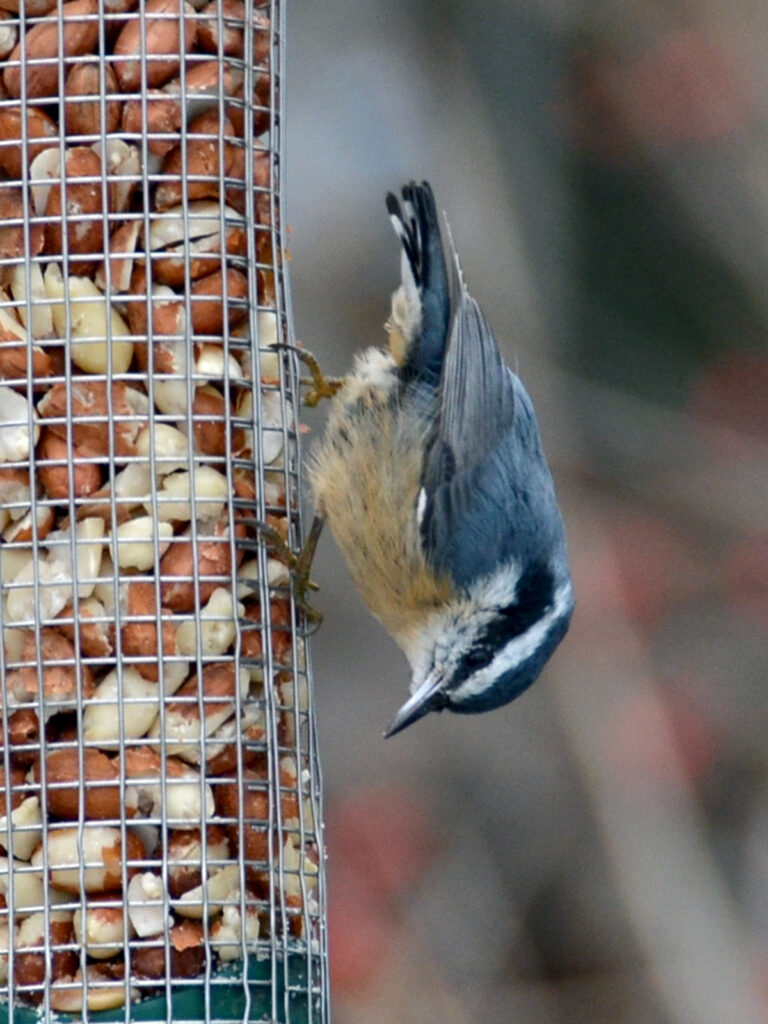
The red-breasted nuthatch is one of those birds, like the pine siskins, that “irrupt” every few years — in other words, we see them in larger numbers due to variations in food supply. They particularly like the peanut feeder, but — like the chickadees — have a “one at a time” rule. Unlike chickadees, however, they stay at the feeder and eat and eat, trying the patience of the one waiting.
The red-breasted nuthatch is one of those birds, like the pine siskins, that “irrupt” every few years — in other words, we see them in larger numbers due to variations in food supply. They particularly like the peanut feeder, but — like the chickadees — have a “one at a time” rule. Unlike chickadees, however, they stay at the feeder and eat and eat, trying the patience of the one waiting.
- Learn more:
- Cornell’s All About Birds: Red-breasted nuthatch
- American Bird Conservancy: Bird of the Week
- Bird Watcher’s General Store: Red-breasted nuthatch
| YR | J | F | M | A | M | J | J | A | S | O | N | D |
| 24 | · | |||||||||||
| 23 | 1 | · | · | · | · | · | 2 | · | ||||
| 22 | · | · | 1 | 1 | 1 | 1 | 1 | 1 | ·1 | |||
| 21 | 2 | 2 | 1 | 2 | 2 | · | · | · | · | · | · | |
| 20 | · | · | 1 | · | · | · | 1 | 2 | 2 | 1 | ||
| 19 | 2 | 1 | 1 | · | · | · | · | · | · | |||
| 18 | · | · | · | · | · | 1 | · | 2 | 1 | |||
| 17 | · | · | · | 1 | · | · | · | · | 1 | · | ||
| 16 | · | · | 1 | 1 | 1 | · | · | · | · | |||
| 15 | · | 1 | 1 | 2 | 1 | 1 | 1 | · | · | |||
| 14 | · | · | · | 1 | · | · | 1 | 2 | 1 | |||
| 13 | 2 | 2 | 1 | · | · | · | · | 1 | ||||
| 12 | · | · | · | · | 1 | · | · | 1 | 2 | |||
| 11 | 2 | 1 | · | · | · | · | · | · | · | · | · | |
| 10 | 1 | 1 | · | · | · | · | · | · | · | 1 | 1 | · |
| 09 | 1 | 1 | 1 | 1 | 2 | · | 1 | · | · | · | 1 | 1 |
| 08 | 1 | 2 | 2 | 1 | 1 | 3 | 1 | 1 | · | · | 1 | 1 |
| 07 | 2 | 2 | 1 | 1 | 1 | · | · | · | 1 | · | 1 | 1 |
| 06 | 1 | 1 | 2 | 1 | · | 1 | · | · | · | · | 2 | 1 |
| 05 | · | 1 | 1 | 1 | · | · | · | 1 | 1 | 1 | 1 | 2 |
| 04 | 2 | 2 | 2 | 1 | · | 1 | · | · | · | 1 | 1 | 1 |
| 03 | · | · | · | · | · | 1 | · | · | · | · | 1 | 2 |
| 02 | · | 1 | 2 | 2 | 1 | · | · | · | · | · | · | · |
| 01 | · | · | · | · | 2 | 1 |
White-breasted nuthatch (Sitta carolinensis)
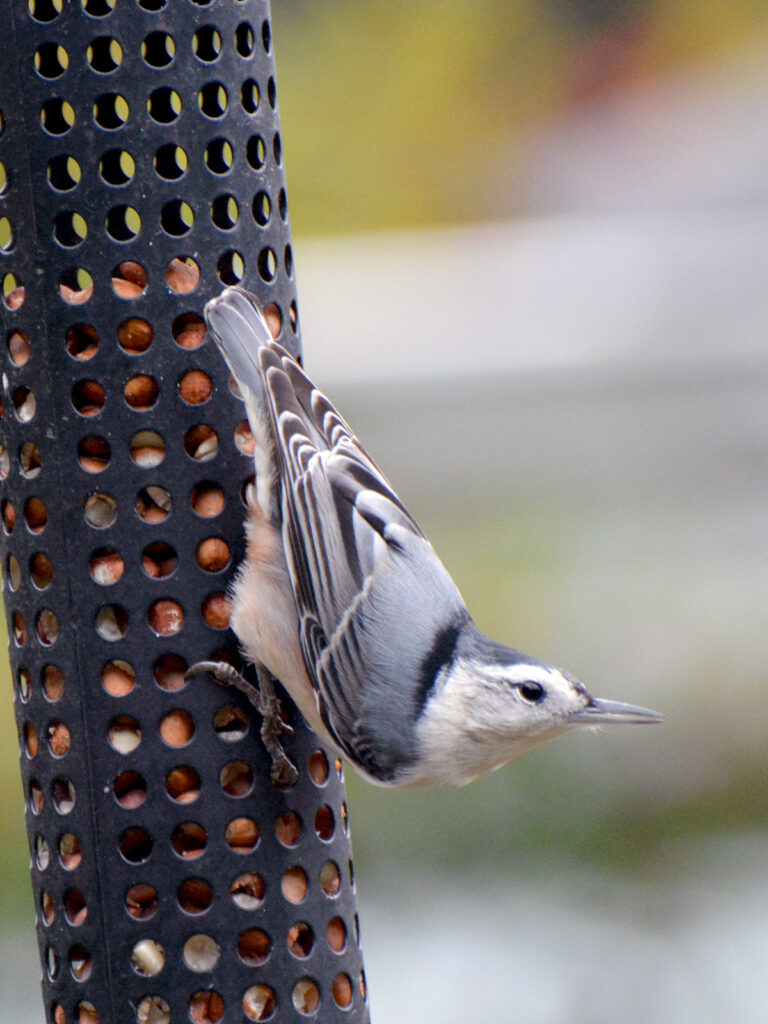
I don’t seem to see these as frequently as I did before they took down a large tree with cavities in the dead trunk. I think they had been using it as a nesting site. I love seeing it work its way upside down on the trunks of trees.
- Learn more:
- Cornell’s All About Birds: White-breasted nuthatch
- American Bird Conservancy: Bird of the Week
| YR | J | F | M | A | M | J | J | A | S | O | N | D |
| 24 | 1 | |||||||||||
| 23 | 2 | 1 | 1 | 2 | · | 1 | 2 | 1 | ||||
| 22 | 1 | · | · | 1 | 2 | 1 | 1 | 2 | 2 | |||
| 21 | 2 | 2 | 2 | 2 | 2 | · | · | · | 1 | · | 1 | |
| 20 | · | · | · | · | 1 | · | · | 2 | 2 | 3 | ||
| 19 | 1 | · | · | 1 | · | 2 | · | · | · | |||
| 18 | 2 | 1 | · | · | 1 | · | 1 | · | 2 | |||
| 17 | 1 | · | 1 | · | 1 | 1 | 1 | · | 1 | 1 | ||
| 16 | 1 | · | 1 | 1 | 1 | · | · | 2 | 1 | |||
| 15 | 2 | 2 | 1 | 1 | 1 | 1 | 1 | · | · | |||
| 14 | 1 | 1 | 2 | 3 | 1 | 2 | 1 | 2 | 2 | |||
| 13 | 2 | 2 | 1 | 1 | · | · | · | 1 | 1 | |||
| 12 | · | 1 | 1 | · | 1 | 1 | 1 | 1 | 1 | |||
| 11 | 1 | 1 | · | 1 | · | · | · | · | · | 2 | 1 | |
| 10 | 3 | 3 | 1 | · | · | · | · | · | · | · | 1 | · |
| 09 | 1 | 1 | 1 | · | · | · | · | · | · | 1 | 1 | 2 |
| 08 | 2 | 2 | 2 | 2 | 1 | · | 1 | 1 | 1 | 1 | 1 | 2 |
| 07 | 1 | 1 | 1 | 1 | 1 | 2 | 1 | · | 1 | 1 | 1 | 2 |
| 06 | 1 | 1 | 2 | 1 | 1 | 1 | 1 | 1 | 1 | · | 1 | 2 |
| 05 | 2 | 1 | 2 | 1 | 1 | 1 | · | 1 | 2 | 1 | 1 | 2 |
| 04 | 1 | 2 | 1 | 1 | 1 | 1 | · | · | 1 | · | 1 | 2 |
| 03 | · | · | 2 | 1 | 1 | 1 | · | 1 | · | 1 | 1 | 1 |
| 02 | · | 1 | 1 | 1 | · | 1 | 1 | · | 1 | · | 1 | · |
| 01 | · | · | 1 | · | 1 | · |
Carolina wren (Thryothorus ludovicianus)
Although I had become familiar with these perky little birds when we were in North Carolina, I was surprised to see a Carolina wren in our yard in Syracuse.
This is one of the few birds new to our yard in recent years, and for a while it was a fairly regular visitor.
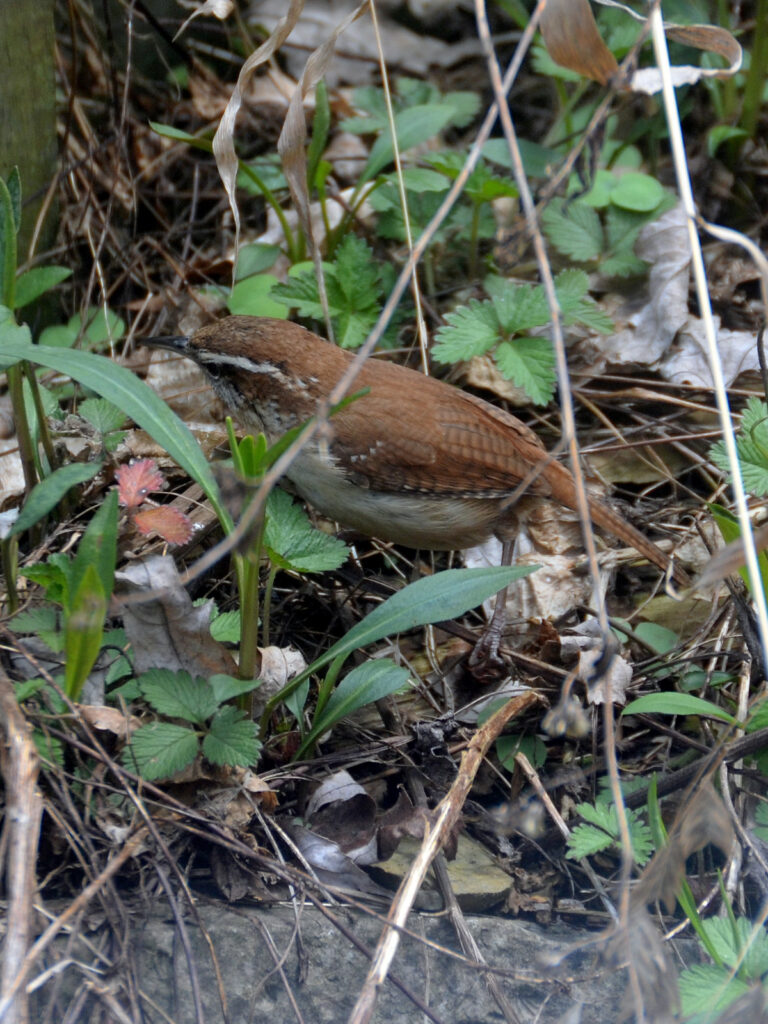
- Learn more:
- Cornell’s All About Birds: Carolina wrens
- American Bird Conservancy: Bird of the Week
- Cool Green Science: Carolina wrens will nest in just about anything
| YR | J | F | M | A | M | J | J | A | S | O | N | D |
| 24 | 2 | |||||||||||
| 23 | · | 2 | 1 | 2 | 2 | 1 | 2 | 2 | ||||
| 22 | · | · | · | · | · | · | 1 | 2 | 1 | |||
| 21 | · | · | · | · | · | · | · | · | 1 | 1 | · | |
| 20 | · | · | · | · | · | · | · | 1 | 1 | · | ||
| 19 | · | · | · | · | · | · | · | · | · | |||
| 18 | · | · | · | · | · | · | · | · | · | |||
| 17 | · | · | · | · | · | · | · | 1 | 1 | · | ||
| 16 | · | · | · | · | · | · | · | · | · | |||
| 15 | · | · | · | · | · | · | · | · | · | |||
| 14 | 1 | 1 | · | 1 | · | 2 | 1 | 1 | 1 | |||
| 14 | 1 | · | · | · | · | · | · | · | · | |||
| 13 | · | · | · | · | 1 | · | · | · | · | |||
| 12 | · | · | · | · | · | · | · | · | · | |||
| 11 | · | · | · | · | · | · | · | · | · | · | · | |
| 10 | · | · | · | · | · | · | · | · | · | · | · | · |
| 09 | · | · | · | · | · | · | · | · | · | · | · | · |
| 08 | · | · | · | · | · | · | · | · | · | · | · | · |
| 07 | · | · | · | · | · | · | · | · | · | · | · | · |
| 06 | · | · | · | · | · | · | · | · | · | · | · | · |
| 05 | · | · | · | · | · | · | · | · | · | · | · | · |
| 04 | · | · | · | · | · | · | · | · | · | · | · | · |
| 03 | · | · | · | · | · | · | · | · | · | · | · | · |
| 02 | · | · | · | · | · | · | · | · | · | · | · | · |
| 01 | · | · | · | · | · | · |
House wren (Troglodytes aedon)
It fits its nickname of “mouse wren.” I’ve frequently mistaken it for some little mouse-like creature when I see it scurry around.
They distinguish themselves with their joyful (and incessant) singing during mating season.
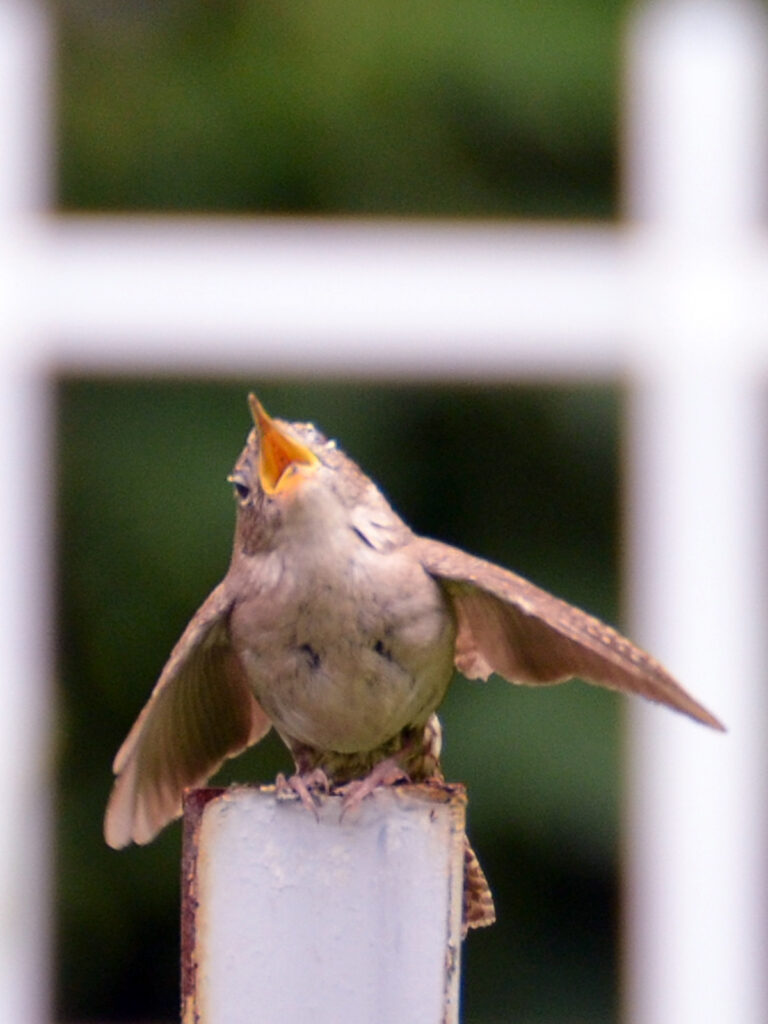
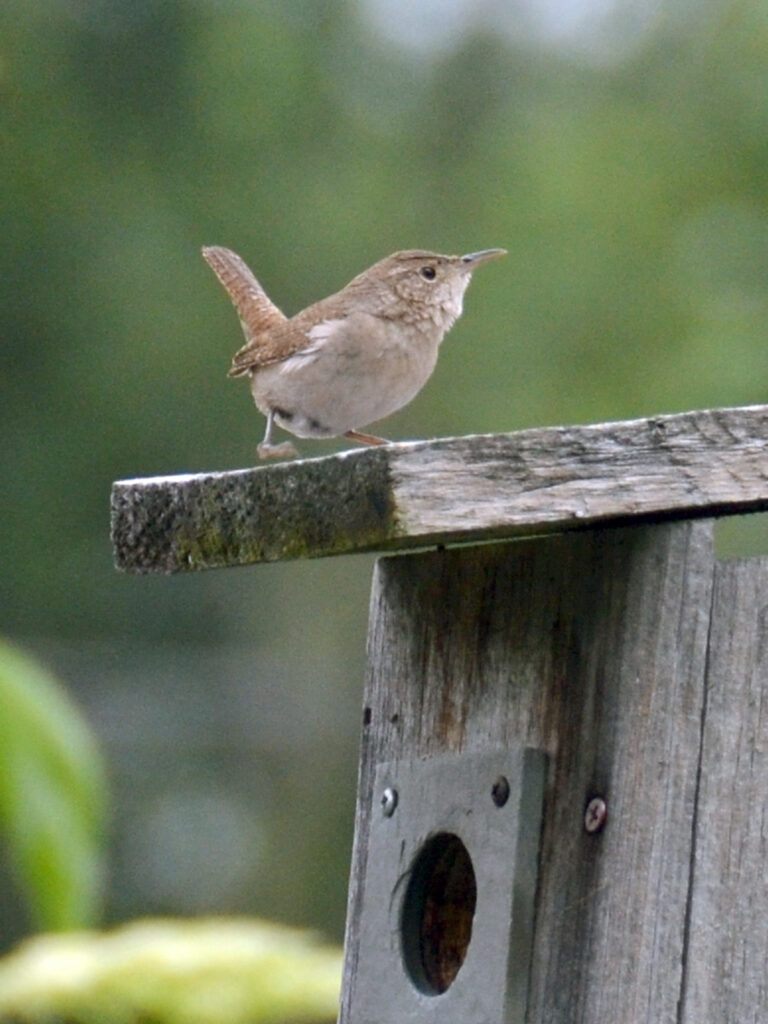
The wrens are very cute with their perky little tails, but it is very annoying when the males put their “wren sticks” on top of the nests the chickadees have started. They take far more of their share of my nest boxes for their trial nests than I would like. Still, I enjoy watching them raise their babies.
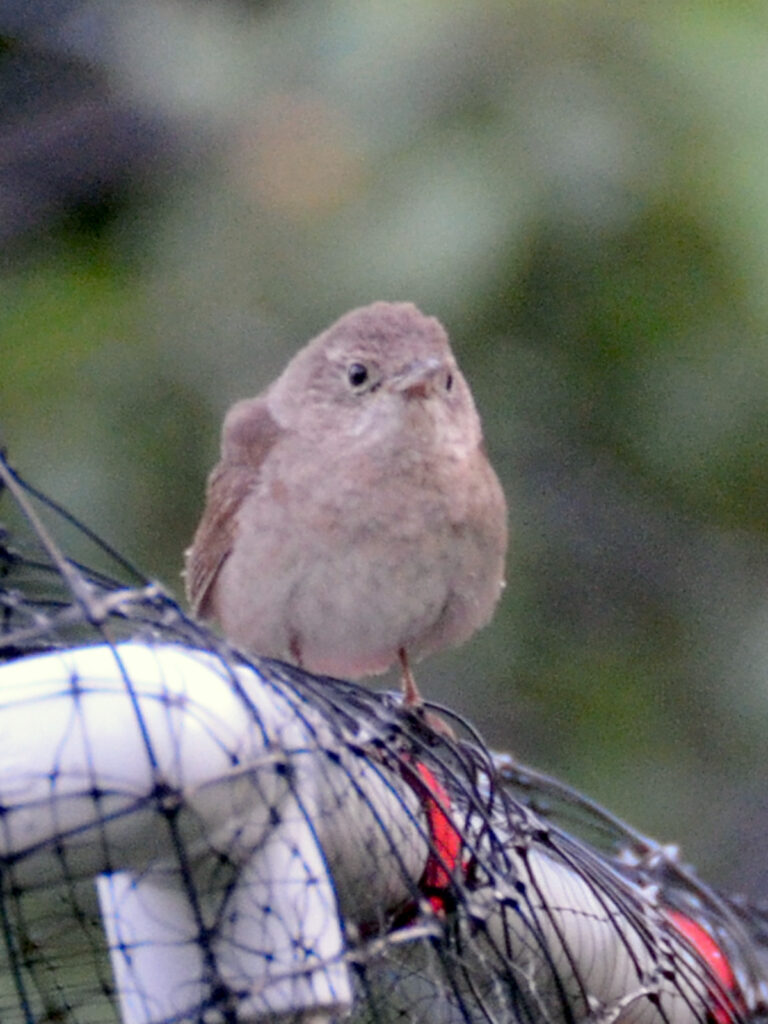
We certainly could tell when these wren babies were around. What a loud little family, chattering as they flit among the trees and shrubs in the front and side yards!
- Learn more:
- Cornell’s All About Birds: House wren
- American Bird Conservancy: House wren
| YR | Arrival | J | F | M | A | M | J | J | A | S | O | N | D |
| 24 | · | ||||||||||||
| 23 | 4/5 | · | 1 | 3 | 3 | 3 | 3 | · | · | ||||
| 22 | 5/5 | · | · | 2 | 3 | 2 | 2 | · | · | · | |||
| 21 | 4/25 | · | · | · | 1 | 2 | 5 | 2 | 8 | · | · | · | |
| 20 | 4/26 | · | 1 | 2 | 4 | 3 | 4 | · | · | · | · | ||
| 19 | 4/21 | · | 2 | 2 | 5 | 3 | 1 | · | · | · | |||
| 18 | 4/29 | · | · | 1 | 3 | 3 | 4 | · | 1 | · | |||
| 17 | 4/23 | · | 2 | 3 | 2 | 4 | 4 | 2 | · | · | · | ||
| 16 | 5/01 | · | · | 2 | 2 | 2 | · | · | · | · | |||
| 15 | 5/03 | · | · | 1 | 1 | 2 | 3 | · | · | · | |||
| 14 | 5/04 | · | · | 2 | 4 | · | 4 | · | · | · | |||
| 13 | 5/12 | · | · | 2 | 4 | 3 | 2 | · | · | · | |||
| 12 | 4/22 | · | 2 | 2 | 6 | 2 | 2 | · | · | · | |||
| 11 | 4/24 | · | · | · | 2 | 2 | 4 | · | · | · | · | · | |
| 10 | 5/02 | · | · | · | · | 2 | 1 | 2 | 2 | · | · | · | · |
| 09 | 4/19 | · | · | · | 1 | 3 | 2 | 2 | · | · | · | · | · |
| 08 | 4/20 | · | · | · | 1 | 1 | 1 | 1 | 1 | · | · | · | · |
| 07 | 5/06 | · | · | · | · | 2 | 2 | 2 | 3 | 1 | · | · | · |
| 06 | 4/02 | · | · | · | 1 | · | 1 | 1 | 1 | · | · | · | · |
| 05 | 4/17 | · | · | · | 1 | · | 1 | · | · | · | · | · | · |
| 04 | · | · | · | 1 | 2 | 1 | 1 | · | · | · | · | · | |
| 03 | · | · | · | · | 2 | 2 | 2 | · | · | · | · | · | |
| 02 | · | · | · | 1 | 2 | 2 | 2 | 3 | · | · | · | · | |
| 01 | · | · | · | · | · | · |
Winter wren (Troglodytes hiemalis)
The Stokes Bird ID book notes that it’s often found where there are rotting logs and shrubs: a perfect description of where I’ve seen it — in the shrubby area near our screen porch alongside the logs lining our paths. And they are rotting — a good thing since it means there’s a lot of little insects and soil creatures working away on them, turning them into soil.
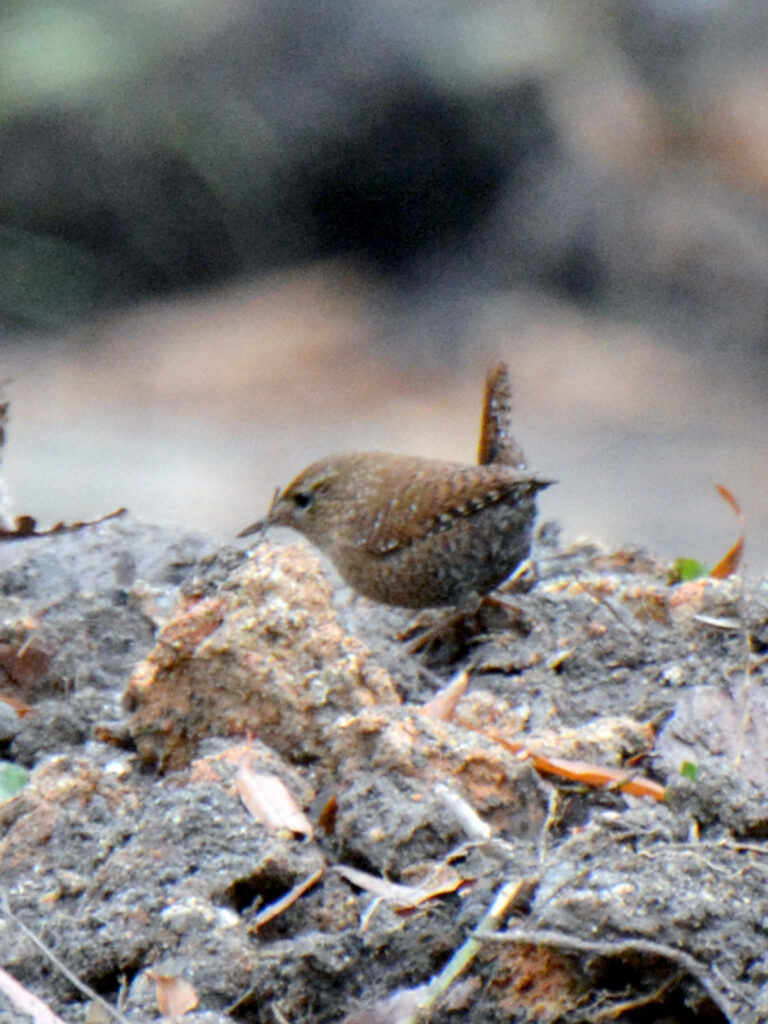
The Stokes Bird ID book also says this bird is “secretive.” That’s an understatement, as well as quite a contrast with the other wrens I’m familiar with: the Carolina wren and the house wren. I’ve had no trouble getting photos of those two kinds of wrens, but the winter wren has been a challenge. (I managed to get its picture when we saw it in North Carolina.) It’s an interesting bird. As All About Birds says, “Per unit weight, the Winter Wren delivers its song with 10 times more power than a crowing rooster.”
- Learn more:
- Cornell’s All About Birds: Winter wren
| YR | J | F | M | A | M | J | J | A | S | O | N | D |
| 24 | · | |||||||||||
| 23 | · | · | · | · | · | · | · | · | ||||
| 22 | · | · | · | · | · | · | · | · | · | |||
| 21 | · | · | · | · | · | · | · | · | · | · | · | |
| 20 | · | · | · | · | · | · | · | · | · | · | ||
| 19 | · | · | · | · | · | · | · | · | · | |||
| 18 | · | · | · | · | · | · | · | · | · | |||
| 17 | · | · | · | · | · | · | · | · | · | · | ||
| 16 | · | · | · | · | · | · | · | · | · | |||
| 15 | · | · | · | · | · | · | · | · | · | |||
| 14 | · | · | · | · | · | · | · | 1 | · | |||
| 14 | · | · | · | · | · | · | · | · | · | |||
| 13 | · | · | · | · | · | · | · | · | · | |||
| 12 | · | · | · | · | · | · | · | · | · | |||
| 11 | · | · | · | · | · | · | · | · | · | · | · | |
| 10 | · | · | · | · | · | · | · | · | · | · | · | · |
| 09 | · | · | · | · | · | · | · | · | · | · | · | · |
| 08 | · | · | · | · | · | · | · | · | · | · | · | · |
| 07 | · | · | · | · | · | · | · | · | · | · | · | · |
| 06 | · | · | · | · | · | · | · | · | · | · | · | · |
| 05 | · | · | · | · | · | · | · | · | · | · | · | · |
| 04 | · | · | · | · | · | · | · | · | · | · | · | · |
| 03 | · | · | · | · | · | · | · | · | · | · | · | · |
| 02 | · | · | · | · | · | · | · | · | · | · | · | · |
| 01 | · | · | · | · | · | · |
